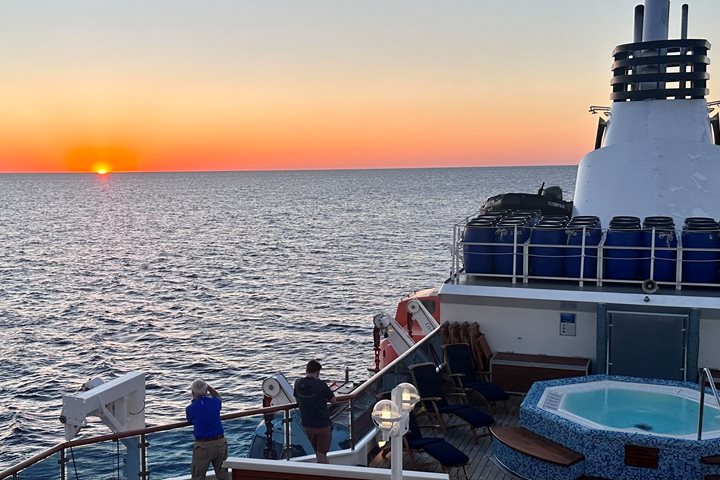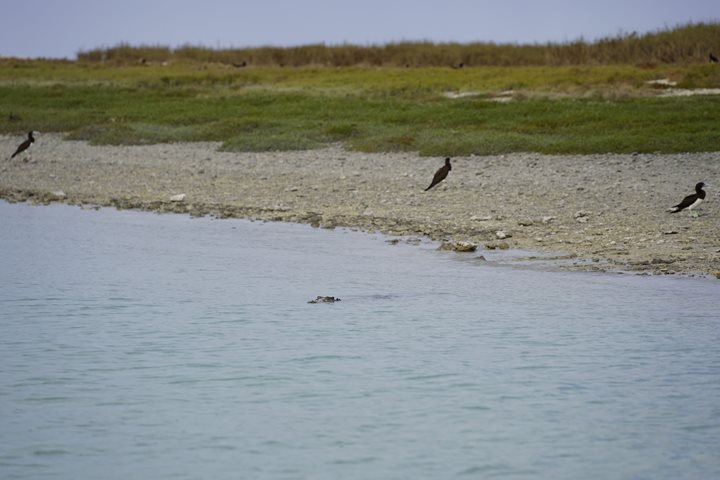Our day began with a new twist. As the sun rose over the Cambridge Gulf, the captain brought the National Geographic Orion alongside the wharf in the small town of Wyndham and the crew rigged the gangway. It was the first time we could simply walk off the ship since leaving Broome a week ago!
We had a choice of adventures for the day – exploration by air or by water. For the aquatic option we boarded coaches immediately after breakfast and made the drive east on the Great Northern Highway to the nearby town of Kununurra. Along the way our driver and guide told us about the settlement of the area, its industrial and agricultural history, the botany of the scrublands and boab forests we passed and several of the important conservation issues that face the region today.
On reaching Kununurra we transferred quickly into a large comfortable boat, covered for protection from the Kimberley sun and with open sides for good viewing and photography. Our journey then took us 55 kilometers up Lake Kununurra, following the course of the old Ord River, which was dammed to form the lake. This water collection scheme, which includes the much larger Lake Argyle upstream, has transformed the region by providing a year-round source of water for irrigation of crops and for the wildlife we had come to see.
The shores of the lake were lined with mangroves and pandanus, tall rushes and low mats of floating vegetation, a green paradise now sustained through the Kimberley’s long dry season and home to thousands of freshwater crocodiles and hundreds of species of birds. We took our time cruising up the calm waters of the lake, stopping for great photo ops of the crocodiles and wallabies, egrets and cockatoos, darters, doves and the very popular comb-crested jacanas. We had a delicious lunch in a shady wilderness picnic area and finished our journey with an ascent of the narrow section of the river, which brought us to the foot of the dam wall that contains Lake Argyle.
At this point we left the boat and boarded our coach for the short drive to the Durack Homestead, the historic residence of the first family to run cattle in the Kimberley. This small house has been moved to its current site from its original location, which is now 30 meters beneath Lake Argyle. As a special bonus, we had an opportunity for excellent close-up views of the bower of a Great Bowerbird, right on the grounds of the homestead.
Meanwhile, the rest of us were off on their own day’s adventure, which was a fantastic flight-seeing excursion over the Ord River, the interior of the Kimberley and the famous Bungle Bungles Mountains World Heritage Site. Taking off from either Wyndham or Kununurra on a crystal clear day under bright blue skies, we spent over two hours in the air, enjoying great views of the two big lakes, the wave-like Osmond Ranges, and the Argyle diamond mine – source of the Kimberley’s famous pink and champagne diamonds. Of course, the highlight of the trip was the Bungle Bungles themselves, an amazing cluster of sandstone karst mountains rising abruptly from the surrounding scrublands. Carved by wind and water into wonderful, whimsical beehive shapes, the Bungle Bungles are also beautifully decorated with horizontal bands of orange and black rock, making a unique otherworldly landscape. Our pilot made a long loop over this Dr. Seuss kingdom, banking the small plane to give us the best possible angles for photography and to let us peer down into the depths of the dramatic canyons that cut through the range.
Back on our ship at the end of the day we gathered for sunset cocktails on Deck Six, chatting happily as we compared our experiences and described the highlights of each excursion. All of us had gained a delightful new perspective on the Kimberley, from the air and from the water, into the interior of this remote corner of the continent.







